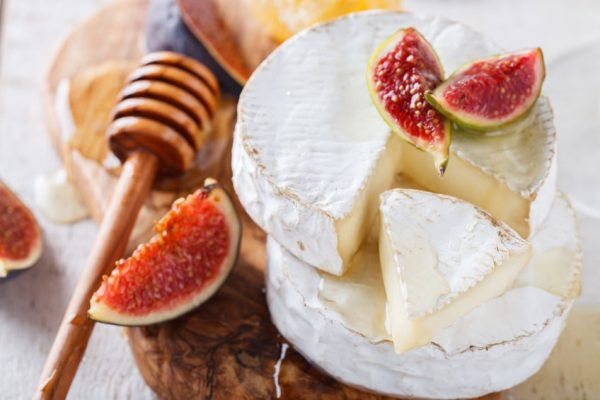What is Brie? The Creamy Heart of French Gastronomy

Welcome to our gastronomic journey into the heart of French cuisine, where we explore one of the most celebrated culinary delights – Brie. This creamy, indulgent cheese, with its distinctive velvety rind, has captivated palates worldwide and stands as a testament to the French passion for artisan food craftsmanship.
Originating just a stone’s throw from Paris in the town of Meaux, Brie is not just another cheese – it’s an experience that embodies the spirit of French gastronomy. Whether served on a rustic cheese board, melted into a gourmet dish, or enjoyed on its own, Brie brings a touch of luxury to any occasion.
In this post, we delve into the fascinating world of Brie, exploring its history, production, and the unique characteristics that have earned it the nickname ‘Queen of Cheeses’. So, sit back and prepare to immerse yourself in the creamy heart of French gastronomy.
Quick Facts About Brie
| Fact | Description |
|---|---|
| Origin | Brie region of France |
| Milk Source | Cow’s milk |
| Texture | Soft and creamy |
| Flavor | Mild, nutty, and slightly sweet |
| Color | Pale yellow with a white edible rind |
| Aging Process | Aged for a minimum of four weeks |
| Varieties | Brie de Meaux and Brie de Melun are the most famous varieties |
| Uses | Often served at room temperature on cheese boards, in sandwiches, or baked in pastry |
| Pairings | Pairs well with Champagne, fruits, nuts, and honey |
| Nutritional Value | High in protein and rich in vitamins B12 and B2 |
What is Brie?

Brie is a renowned French cheese, often referred to as the “Queen of Cheeses”. This prestigious title speaks volumes about its esteemed position in the world of gourmet foods. Originating from the Brie region in France, this cheese has managed to capture the hearts and palates of cheese lovers across the globe.
One of the defining characteristics of Brie is its unique texture and appearance. It’s a soft-ripened cheese made mainly from cow’s milk, boasting a creamy, pale interior encased within an edible white rind. This bloomy rind is the result of the cheese being treated with a white mold known as Penicillium candidum. This mold aids in the aging process, maturing the cheese from the outside in and lending it a distinctive, slightly mushroom-like flavor.
When it comes to taste, Brie offers a rich, buttery flavor profile. It beautifully balances both sweet and savory notes, often accompanied by a hint of tanginess. The exact taste can vary depending on factors such as the diet of the cows and the specifics of the aging process. As a result, some Brie varieties might surprise you with subtle undertones of grass, mushroom, nuts, or even fruit.
What makes Brie truly stand out is its incredible versatility in the culinary world. Whether it’s served at room temperature on a cheese platter, melted into a decadent grilled cheese sandwich, or baked to perfection with honey and nuts for a luxurious appetizer, Brie consistently delivers an unforgettable gastronomic experience.
What Does Brie Taste Like?
Brie cheese is renowned for its distinctive yet mild flavor profile. The taste of Brie can be described as rich and buttery with a slight tanginess. It has a creamy, smooth texture that practically melts in your mouth.
The interior of Brie cheese, known as the “paste,” offers a subtle sweetness that is perfectly balanced by savory, slightly earthy notes. When it’s well-ripened, Brie can also develop deeper flavors, reminiscent of mushrooms or even truffles, which adds to its complexity.
The white rind that encases Brie, known as the bloomy rind, is completely edible and contributes a slight moldy or mushroom-like flavor to the overall taste. This rind can add an interesting textural contrast to the creamy interior.
It’s worth noting that the flavor of Brie can vary depending on factors such as the specific region it comes from, the diet of the cows whose milk was used to make it, and the exact aging process it undergoes. These factors can result in subtle nuances in flavor, ranging from hints of grass or nuts to undertones of fruit.
Whether enjoyed on its own, paired with fruits, nuts, or bread, or melted into a delicious dish, Brie is a delight for the palate with its unique combination of flavors and textures.
How to Eat Brie Cheese Like a Pro

Brie cheese is a versatile culinary delight that can be enjoyed in a multitude of ways. It’s quite customary to eat the whole wheel of Brie, as the signature bloomy rind is an integral part of its flavor profile.
One traditional way to consume Brie is to serve it with crusty bread or crackers, offering a delightful contrast between soft cheese and crunchy accompaniments. However, Brie’s mild and creamy flavor also pairs well with a variety of fruits, nuts, and honey, allowing for creative culinary explorations.
Also read: 11 Best Crackers that Pair Well with Cheese
To fully appreciate the flavors of Brie, it’s recommended to serve it once it has ripened. A ripe Brie will have a slight give on the outside of the rind. Also, Brie can be served at room temperature or slightly chilled, so you may want to remove it from the refrigerator a bit before serving to allow it to reach the desired temperature.
If you’re serving Brie at a gathering, it’s customary to slice it into wedges radiating outwards from the center, just like you would slice a cake. And if you’re looking for a beverage to pair with your Brie, a glass of wine makes for a classic combination.
Also read: A Comprehensive Guide to Enjoying Cheese Platter with Wine
The 2 Most Popular Types of Brie
| Brie de Meaux | Brie de Melun | |
|---|---|---|
| Origin | Named after the town of Meaux in the region of Île-de-France, near Paris. | Originates from the town of Melun, also in the Île-de-France region. |
| AOC/AOP Status | Has been awarded AOC (Appellation d’Origine Contrôlée) and AOP (Appellation d’Origine Protégée) status, which guarantee its quality and authenticity. | Also holds AOC and AOP status. |
| Milk Used | Made from raw, unpasteurized cow’s milk. | Typically made from raw, unpasteurized cow’s milk but can be made from pasteurized milk too. |
| Texture | Creamy and buttery with a firm and edible white rind. | Firmer and less creamy than Brie de Meaux, with a stronger, more pungent flavor. |
| Taste | Rich, creamy, and fruity with a slight note of mushrooms and nuts. | More robust and salty, with an earthy, slightly sour aftertaste. |
| Maturing Time | Usually matured for 4 to 8 weeks. | Typically matured for a longer period of 7 to 10 weeks. |
| Pairings | Pairs well with Champagne, fresh fruits, and crusty bread. | Complements full-bodied red wines and robust flavors. |
Why is Brie so expensive?
Several factors contribute to the cost of Brie cheese, making it more expensive compared to some other types of cheese.
- The production process of Brie is labor-intensive and time-consuming. It requires the cheese to be carefully aged under specific conditions to develop its unique flavor and texture. This process necessitates specialized knowledge, facilities, and equipment, all of which contribute to the production cost.
- The ingredients used in Brie are high-quality. The best Brie is made from raw, unpasteurized milk, which can be more expensive than regular milk. Furthermore, Brie is typically made in smaller batches, which can increase the unit cost compared to mass-produced cheeses.
- The cost of animal feed and fertilizers for dairy farming has risen due to inflation, contributing to the overall increase in the cost of cheese production.
- Import costs can also influence the price of Brie, particularly if you’re buying it outside of France. Factors such as import taxes, shipping fees, and retailer markups can all add to the final price you pay at the store.
It’s important to note that while Brie is more expensive than some cheeses, it’s not among the most costly. Specialty cheeses such as Bitto or cheeses made from the milk of rare animals can command much higher prices.
What pairs well with Brie?

Food that pairs well with Brie:
| Food Category | Specific Foods |
|---|---|
| Fruits | Apples, Pears, Grapes, Berries |
| Nuts | Almonds, Walnuts, Pecans |
| Meats | Prosciutto, Salami, Smoked Salmon |
| Breads/Crackers | Baguette, Whole Grain Crackers, Sourdough |
| Jams/Preserves | Fig Jam, Raspberry Preserves, Apricot Jam |
| Other Cheeses | Camembert, Roquefort, Gouda |
| Vegetables | Roasted Bell Peppers, Olives, Pickles |
| Desserts | Dark Chocolate, Honeycomb, Shortbread Cookies |
Also read: What Fruit Goes on a Charcuterie Board?
Beverage that pairs well with Brie:
| Beverage Category | Specific Beverages |
|---|---|
| White Wines | Chardonnay, Sauvignon Blanc |
| Red Wines | Beaujolais, Cabernet Franc, Cabernet Sauvignon |
| Rosé Wines | All types of Rosé |
| Champagne | All types of Champagne |
| Beer | Saison, Bière de garde, white, light lagers, cherry-flavoured beer |
Also read: A Comprehensive Guide to Enjoying Cheese Platter with Wine
Should Brie be eaten hot or cold?
Brie cheese can be enjoyed both hot and cold, depending on your preference and the specific dish you’re preparing.
When served cold or at room temperature, Brie has a firm but creamy texture. It’s perfect for cheese boards, sandwiches, or simply spread on a piece of crusty bread. If you’re serving Brie as part of a cheese platter, it’s best to take it out of the refrigerator about an hour before serving. This allows the cheese to warm slightly, enhancing its flavor and creaminess.
On the other hand, heating Brie brings out its wonderfully gooey texture, making it ideal for recipes like baked Brie with honey and nuts, Brie en croute (Brie wrapped in puff pastry and baked), or melted on top of a gourmet pizza.
Whether you prefer your Brie hot or cold, one thing is certain: this versatile cheese can add a touch of luxury to any dish.
Brie tasting notes
- Texture: Brie has a creamy, smooth, and slightly gooey texture that is particularly noticeable when served at room temperature or heated. The rind adds a contrasting firmer texture.
- Color: The interior of Brie, known as the “paste,” is pale yellow while the edible rind is white.
- Smell: Brie emits a mild, slightly earthy aroma. Some may also detect a hint of ammonia, especially in well-ripened Brie.
- Taste: The primary flavor of Brie is buttery and rich, with a slight tang. It also has subtle sweet and savory notes.
- Rind Flavor: The bloomy rind contributes a mild moldy or mushroom-like flavor. This can add an interesting dimension to the overall taste of the cheese.
- Aftertaste: Brie often leaves a mild, creamy aftertaste. Depending on the specific variety and how well it’s aged, you may also notice a lingering nutty or fruity flavor.
- Flavor Variations: The flavor of Brie can vary depending on several factors. For instance, the diet of the cows whose milk was used can result in subtle undertones of grass or nuts, while the aging process can influence the intensity of the flavors.
- Pairings: Brie pairs well with a variety of foods and drinks. It goes well with fresh fruits like apples and grapes, nuts, honey, and crusty bread. When it comes to wine, it pairs nicely with Champagne, a light-bodied Pinot Noir, or even a fruity Beaujolais.
7 best Brie Substitutes: Alternatives
| Cheese | Country of Origin | Flavor | Texture |
|---|---|---|---|
| Camembert | France | Earthy, mushroomy, slightly nutty | Soft, creamy |
| Coulommiers | France | Mild, buttery, slightly fruity | Soft, creamy |
| Chaource | France | Milky, slightly salty and acidic | Soft, creamy |
| Brillat-Savarin | France | Rich, buttery, slightly acidic | Soft, creamy |
| Cremont | United States | Nutty, tangy, slightly sweet | Soft, creamy |
| Delice de Bourgogne | France | Rich, creamy, full-flavored | Soft, creamy |
| Robiola Bosina | Italy | Mild, tangy, slightly sweet | Soft, creamy |
The pros and cons of Brie
Benefits:
- Rich and creamy texture that enhances many dishes
- Versatile, can be used in a variety of recipes from appetizers to desserts
- High in protein, providing about 6 grams per ounce
- Contains a good amount of vitamin B12 and calcium
- The rind is edible and can add a different flavor profile
- Pairs well with a variety of wines, fruits, and breads
Drawbacks:
- High in saturated fat, which can contribute to high cholesterol levels if consumed in excess
- Can be high in sodium, which may not be suitable for those on a low-sodium diet
- Not suitable for individuals with lactose intolerance or milk allergies
- Can spoil quickly once cut, typically lasts only one to two weeks in the fridge
- Some people find its strong smell off-putting
Brie Nutrition Facts
The nutritional content of 100 grams of Brie Cheese:
| Nutrient | Quantity |
|---|---|
| Calories | 334 kcal |
| Protein | 20.75g |
| Total Fat | 27.68g |
| Carbohydrate | 0.45g |
| Sodium | 629mg |
| Cholesterol | 100mg |
The History of Brie
Brie cheese has a rich history that dates back to the 8th century. It originated in the region of Île-de-France, near Paris, which is still the primary production area for this cheese today.
The first recorded mention of Brie dates back to the rule of Charlemagne, the Frankish emperor. According to the tales, he tasted Brie cheese at a monastery in Reuil-en-Brie and was instantly enamored with its creamy texture and distinct flavor.
In the Middle Ages, Brie was a crucial part of tithe (tax) systems, often given to the clergy by peasants as a form of payment or offering. During this period, it was also considered a ‘royal cheese,’ favored by French monarchs like King Louis XVI, who reportedly requested Brie as his last meal before his execution.
Fast forward to the 19th century, during the Congress of Vienna, where European diplomats were introduced to Brie. The French diplomat Talleyrand proposed a contest to determine the “king of cheeses.” After much deliberation, Brie emerged as the winner, earning it the nickname “Le Roi des Fromages” or “The King of Cheeses”.
Today, Brie is loved worldwide for its creamy texture and mild yet deeply satisfying flavor. It is produced in various sizes and even flavors, with some variants incorporating herbs, spices, or truffles. Despite its global popularity, the most traditional versions of Brie, Brie de Meaux and Brie de Melun, are still produced in France and have been granted Protected Designation of Origin (PDO) status by the European Union.
Frequently Asked Questions
1. Should you eat Brie raw?
Yes, Brie cheese can be eaten raw.
In fact, it’s often served raw on cheese boards or in sandwiches. It has a soft, creamy texture and a mild flavor that pairs well with a variety of foods, including fruits, nuts, and breads.
However, some people may prefer to heat or bake Brie, which makes it even creamier and can enhance its flavor.
It’s important to note that while the cheese itself is safe to eat raw, pregnant women and people with weakened immune systems should avoid eating the rind of Brie (and other soft cheeses), as it can contain bacteria like Listeria.
2. Can you eat every part of brie cheese including the white part?
Yes, you can eat all parts of Brie cheese, including the white part which is known as the rind.
The rind is a type of mold, specifically Penicillium candidum, that is safe to eat and adds flavor and texture.
3. Is Brie a stinky cheese?
Brie cheese is known for having a distinct aroma, but it’s typically not categorized as a “stinky” cheese. The smell of Brie is often described as earthy, nutty, fruity, or even mushroom-like.
However, its aroma is generally considered to be much milder compared to traditionally “stinky” cheeses like Limburger or Roquefort.
4. Is brie cheese sweet or salty?
Brie cheese is known for its mild, soft, and creamy flavor profile. It often has a light, buttery scent and flavor, with a slightly salty finish.
While not typically described as sweet, Brie does have a slight sweetness to it, particularly in the aftertaste. It also often exhibits nutty, fruity, and earthy tones, which can contribute to the perception of sweetness.
However, the exact flavor can vary depending on the specific type of Brie and how it’s been aged. For example, Brie de Meaux sometimes has a somewhat sweet taste to go along with a nutty, mushroom flavor.
5. How long will brie last in the fridge?
Brie cheese, when properly stored in the refrigerator, can typically last for about one to two weeks after it’s been opened.
It’s best to keep Brie cheese wrapped in waxed or parchment paper, then loosely covered in plastic wrap or placed in a resealable bag. This allows the cheese to breathe while still maintaining a high level of moisture.
If you notice any mold on the cheese that’s not part of the original rind, or if it develops an off smell or slimy texture, it’s safest to discard it.
Also read:
- A Guide to Provolone: A Masterclass in Flavor and Versatility
- Pecorino Romano: The Ultimate Guide to Italy’s Age-Old Cheese
- The Art of Blue Vein Cheese: A Journey Through Flavor and Texture
- A Guide to Havarti: The Star Cheese of the Culinary World
- Savor the Flavor: 20 Cheeses with the Least Lactose
- Best Wine and Cheese Pairings: The Ultimate Guide
- Cheese Curds: The Unsung Heroes of the Dairy World





